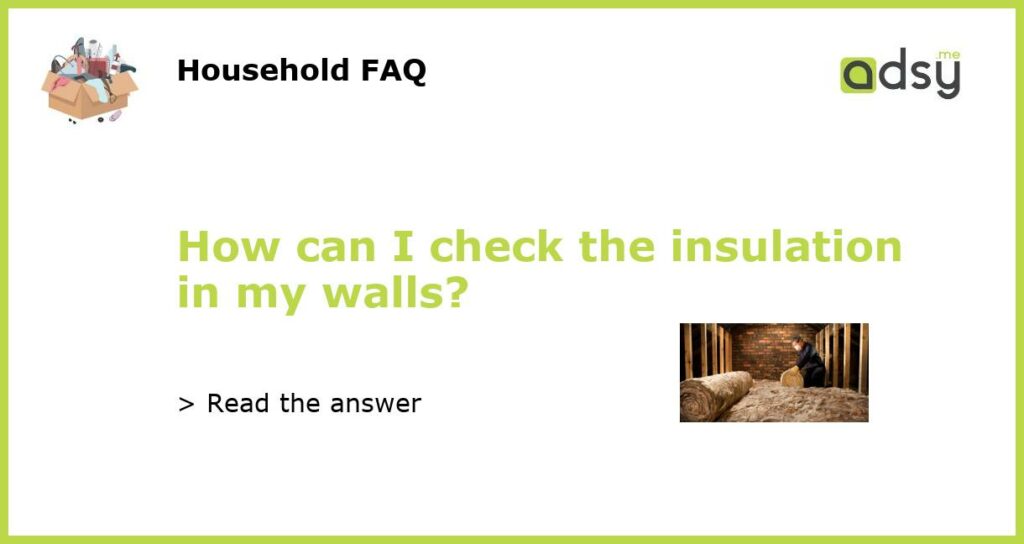Why Is It Important to Check the Insulation in Your Walls?
Proper insulation is crucial for maintaining a comfortable and energy-efficient home. Insulation helps to regulate the temperature inside your home, keeping it warm in the winter and cool in the summer. It also helps to reduce energy consumption and lower your utility bills. Insulation is typically installed in the walls, attic, and basement of a house. Over time, however, the quality of insulation can deteriorate, making it less effective. Therefore, it is important to regularly check the insulation in your walls to ensure that it is still providing adequate thermal protection.
Signs That Your Wall Insulation May Need Attention
There are several signs that may indicate that your wall insulation needs attention. The first and most obvious sign is a noticeable change in the temperature inside your home. If your home feels drafty or if certain rooms are consistently colder than others, it could be a sign that the insulation in your walls is not doing its job properly.
Another sign to look out for is a significant increase in your utility bills. If you notice that your heating or cooling costs have suddenly gone up, it could be due to poor insulation. Inadequate insulation allows heat to escape in the winter and enter in the summer, which can result in increased energy consumption.
You may also notice that your HVAC system is working harder than usual to maintain a comfortable temperature. This is because a lack of proper insulation puts extra strain on your heating and cooling system, as it has to work harder to compensate for the temperature fluctuations.
Lastly, if you notice any mold growth or moisture issues on the walls, it could be a sign of poor insulation. Moisture can easily seep into the walls if the insulation is not properly protecting them, which can lead to mold growth and other structural problems.
DIY Methods for Checking Wall Insulation
If you suspect that your wall insulation may need attention, there are a few DIY methods you can try before calling in a professional:
One of the simplest ways to check the insulation in your walls is to visually inspect them. Look for any obvious gaps, cracks, or holes in the walls where insulation may be missing or damaged. Pay close attention to areas around windows, doors, and electrical outlets, as these are common areas for insulation problems.
You can also touch the walls to feel for any temperature differences. Well-insulated walls will feel relatively warm in the winter and cool in the summer. If you notice any areas that feel significantly colder or warmer than the rest of the wall, it could be a sign of insulation issues.
Another method is to use a thermal imaging camera, which can help identify areas of heat or cold leakage in the walls. The camera will display color variations based on temperature differences, allowing you to pinpoint areas where the insulation may be lacking.
Lastly, you can conduct a smoke test by lighting a stick of incense and holding it near the walls. If you notice that the smoke is being pulled towards or pushed away from certain areas, it could indicate air leakage and poor insulation.
When to Call in a Professional
If you have tried the DIY methods mentioned above and still suspect that your wall insulation is inadequate, it may be time to call in a professional. A professional insulation contractor will have the tools and expertise to accurately assess the quality of your insulation, identify any issues, and recommend the appropriate solutions.
They may perform a blower door test, where a fan is installed in an exterior door to create negative pressure in the house. This helps to identify air leaks and insulation problems that may not be easily visible. In some cases, they may also use infrared cameras or other advanced diagnostic tools to assess the insulation quality.
The Benefits of Upgrading Your Wall Insulation
If it is determined that your wall insulation needs to be upgraded, there are several benefits you can expect to enjoy:
Better Energy Efficiency: Upgrading your wall insulation can significantly improve the energy efficiency of your home. This means that your heating and cooling system will not have to work as hard to maintain a comfortable temperature, resulting in lower energy bills.
Enhanced Comfort: Proper insulation helps to regulate the temperature inside your home, making it more comfortable throughout the year. You can say goodbye to drafty rooms and fluctuating temperature levels.
Noise Reduction: Insulation also helps to reduce noise transmission between rooms, creating a quieter and more peaceful living environment.
Environmental Benefits: By reducing your energy consumption, upgrading your wall insulation can help to lower your carbon footprint and contribute to a more sustainable future.
In conclusion, checking the insulation in your walls is an important task that can help improve the energy efficiency, comfort, and overall performance of your home. Regular inspections and necessary upgrades will ensure that your home stays cozy while saving on energy costs.

